#pool dehumidifiers
Text
youtube
HVAC Preventative Maintenance Palatine & Libertyville, IL
https://alliedairheat.com/preventative-maintenance/ - HVAC technicians at Allied Air Conditioning & Heating Corporation have the skills, knowledge, and experience to perform expert HVAC preventative maintenance. Our Illinois service areas: Mundelein, Vernon Hills, Arlington Heights, Barrington, Inverness, Hoffman Estates, Lake Forest, Lake Zurich, Buffalo Grove, etc. We have two convenient locations to serve Chicagoland, from Glen Ellyn to Zion:
500 E Northwest Hwy Palatine, IL 60074
847-262-3349
203 Peterson Rd Libertyville, IL 60048
847-367-8989
0 notes
Text
this is the first night this week I haven’t had to spend my evening doing work so you know what that means….
I cleaned my house!
#I vacuumed the pool I vacuumed the carpets I vacuumed the stairs!#I sprayed for weeds I swept and mopped the floors!#I checked the mail and I emptied the dehumidifier!#I feel unstoppable! but also tired#so now it’s time to pump and shower and then try to take it easy as much as possible tomorrow
5 notes
·
View notes
Text
Optimal Humidity Control: Why Duct Dehumidifiers are Best for Large Indoor Pools!
Optimize your indoor swimming pool environment with our versatile dehumidifiers in ducted, wall-mounted, and freestanding types. Each option is designed to efficiently control humidity, prevent mold growth, and protect your facility from moisture damage. Ensure a comfortable, healthy atmosphere for all swimmers with our reliable dehumidification solutions. Choose the perfect system to suit your specific needs. Call us in Dubai, Doha, Jeddah, Riyadh, Erbil, Amman, Muscat, Kuwait, Baghdad, and Manama. #SwimmingPoolDehumidifier #HumidityControl #IndoorPool #Dehumidifier #ctrltech4u https://www.dehumidifier.ae/dehumidifiers/best-indoor-pool-dehumidifier.php
Ceiling dehumidifiers offer several advantages over portable, freestanding, wall-mounted systems for large indoor pools in hotels, schools, clubs, and similar facilities. Integrating seamlessly with existing HVAC systems, they provide uniform and consistent humidity control throughout the pool area, ensuring effective moisture management in every corner. Hidden within the ductwork, these humidity dryers maintain the space's aesthetic appeal and free up valuable floor and wall areas. Their design enhances efficiency, working seamlessly with HVAC systems to maintain optimal humidity levels more effectively than standalone units. Additionally, duct dehumidifiers operate more quietly since the central unit is often located away from the pool area, contributing to a peaceful and enjoyable environment for pool users.
Experience the benefits of seamless, efficient, and quiet dehumidification with our ducted dehumidifiers for hotels, schools, clubs, and spas.
0 notes
Photo

Hot Tub - Contemporary Pool
Hot tub - large contemporary indoor concrete and rectangular hot tub idea
#black tile pool lines#dehumidifiers#medium wood trimmed window#automatic pool covers#beige stucco wall#indoor pool ideas#bar
0 notes
Text
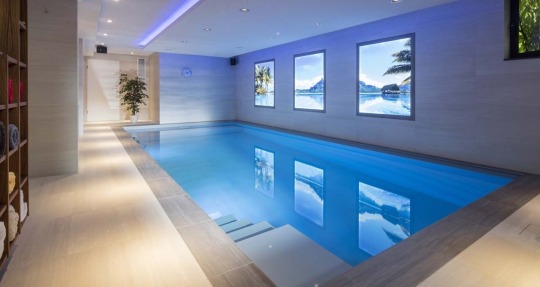
Swimming Pool Dehumidifiers
Swimming pools are a great source of fun and relaxation, but they can also be a breeding ground for mold and mildew if the humidity levels are not managed properly. That's where swimming pool dehumidifiers come in. In this blog post, we'll discuss what swimming pool dehumidifiers are, how they work, and why they are important for maintaining a healthy and comfortable pool environment.
What are swimming pool dehumidifiers?
Swimming pool dehumidifiers are devices that are designed to remove excess moisture from the air in an indoor swimming pool area. Excessive humidity levels can cause a range of problems, such as foggy windows, musty odors, and the growth of mold and mildew. A dehumidifier works by pulling moisture from the air, condensing it into water, and draining it away.
How do swimming pool dehumidifiers work?
Swimming pool dehumidifiers come in a variety of sizes and types, but they all work in a similar way. They use a fan to draw in humid air from the pool area, which is then passed over a set of refrigerated coils. The coils cool the air, causing the moisture to condense into water droplets. The dry air is then blown back into the pool area, while the water droplets are drained away.
Some dehumidifiers also use a desiccant material, such as silica gel, to absorb moisture from the air. These types of dehumidifiers are often used in commercial swimming pool environments, where there is a higher volume of air to be processed.
Why are swimming pool dehumidifiers important?
Swimming pool dehumidifiers are important for several reasons. Firstly, they help to maintain a comfortable and healthy pool environment. High humidity levels can make the air feel heavy and damp, which can be uncomfortable for swimmers. They can also lead to the growth of mold and mildew, which can cause respiratory problems and aggravate allergies.
Secondly, swimming pool dehumidifiers can help to protect the structure of the building. High humidity levels can cause damage to walls, floors, and ceilings, as well as to any equipment or furniture in the pool area.
Finally, swimming pool dehumidifiers can help to reduce energy costs. Excessive humidity can make it more difficult to heat or cool a pool area, as the excess moisture in the air can act as a barrier to temperature control. By removing the moisture from the air, a dehumidifier can help to make the pool area more energy-efficient.
In conclusion, swimming pool dehumidifiers are an important tool for maintaining a healthy and comfortable pool environment. They work by removing excess moisture from the air, which helps to prevent the growth of mold and mildew, protect the structure of the building, and reduce energy costs. If you have an indoor swimming pool, a dehumidifier is an essential investment that will help to ensure that your pool area is always clean, dry, and comfortable.
0 notes
Text
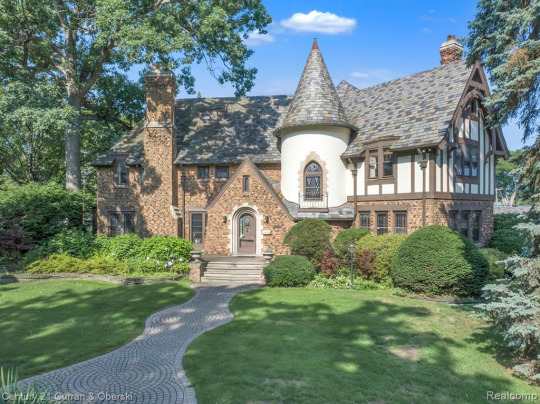
1928 castle like Tudor in Dearborn, Michigan is kinda quirky. 8bds, 4ba, $1.289M.
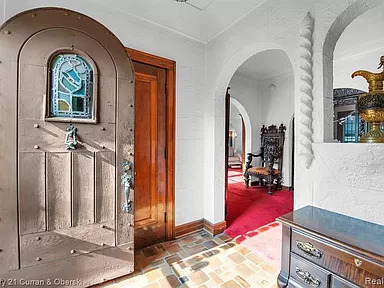
It has a fairly large entrance foyer with a closet.

This is very different, isn't it? This home has quite a few wall niches, too.
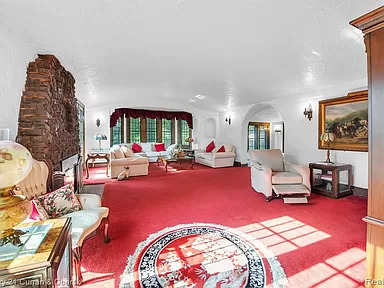

Large living room has an unusual fireplace. There's even a niche in the fireplace.

Sunken sun room. The house has some very different features.

This is odd. A toilet in the middle. I wonder if there's anything behind there, or is it just a powder room.
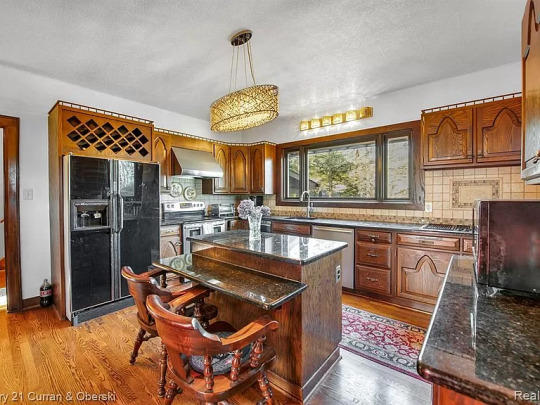

The kitchen's nice. Even if the cabinets are dated, the design is castle-like and original to the home.

Nice dinette for everyday and it has a deep niche in the wall.

Very large sunny dining room. The crease in the carpet indicates that it needs to be stretched by a carpet installer.
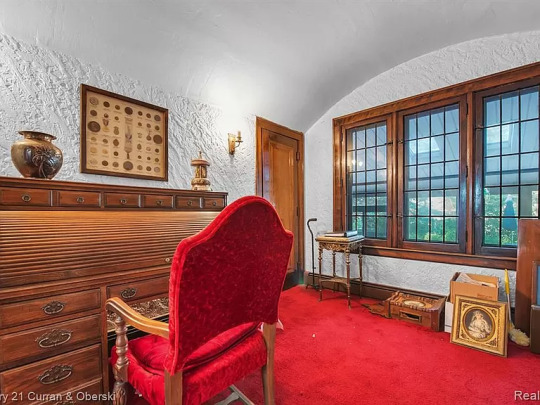

The home office has interesting shelving. Like the rounded ceiling.
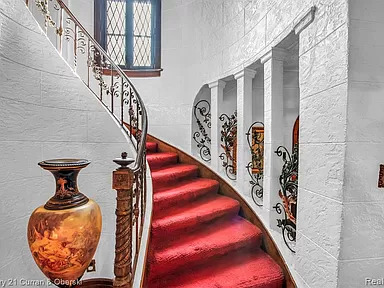
I wonder what color the walls were before they painted them. They probably weren't this stark. More than likely they were yellowish.

Beautiful stairs and landing. I wonder what it cost to paint this whole house.

The primary bedroom is big.

The en-suite has a vintage tub and tile. It looks original, except for the bowl sinks, but the cabinet was painted.

This bedroom was converted to a closet.
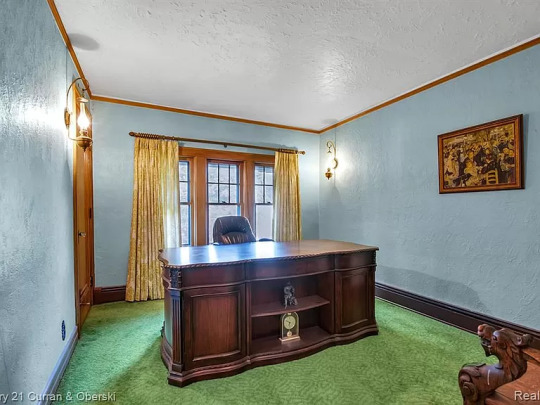
This is another bedroom that happens to have a desk. Not a fan of the carpeting- it looks faded and is showing its age.

Bathroom #2 has a long shower and mismatched plumbing fixtures.

This bedroom is a good size.

Interesting bath has a 70s sink.

Large finished basement must be damp b/c they left the dehumidifier out. Looks like a wine rack in the wall.
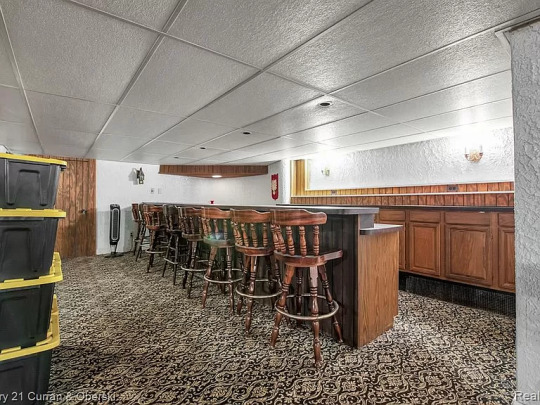
Very large bar.

Nice enclosed porch.

This is nice- a patio with a large brick outdoor kitchen.

There's also a pool.


Nice large yard and the lot is .52 acre.
138 notes
·
View notes
Text
homunculus facts¡
if you put a homunculus in your humidifier' the resulting mist will give you 0•001‰ of our immortality• basically just enough to feel well·rested when you wake up one morning•
if you put a homunculus in your dehumidifier' it will become soggy and sad like a cat who fell in a pool•
if you put a dehumidifier in your homunculus' you make a joke from like' 2010•
#homunculus#homunculus facts#wizardposting#unreality#alchemy#humidifier#dehumidifier#yo dawg i heard you like old memes
53 notes
·
View notes
Text
It's hot and humid today and I'm WFH so I hauled both the dehumidifier and the fan in here and I'm absolutely being blasted by white noise. 10/10 nothing is allowed to make noise at me. Tiger could be 3 inches behind me and I wouldn't know. For some reason my monkey instincts love this. If fans had existed 10 million years ago I'd have been blasted out of the gene pool for this.
97 notes
·
View notes
Text
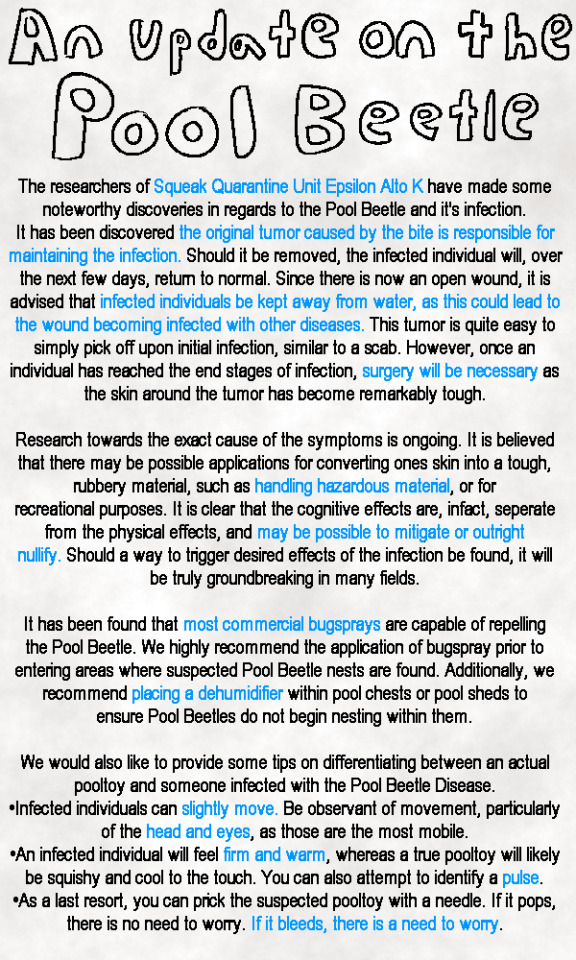
So after a discussion with @catboybeebop about the Pool Beetle, we had some ideas on ways the infection could be reverted, and I was inspired to make this little follow up :3. Hope you don't mind Jeffy, if you do please let me know.
It's not nearly as permanent as one would think, and since they only really nest in specific environments, it's pretty easy to prevent them from showing up to begin with. It's also not too hard to tell a real pooltoy apart from somebody infected, just gotta look closely, maybe give 'em a poke.
Also I still feel bad about the concept scaring you Jeffy I'm sorry :(
Transcript under cut cause it's long
The researchers of Squeak Quarantine Unit Epsilon Alto K have made some noteworthy discoveries in regards to the Pool Beetle and it's infection. It has been discovered the original tumor caused by the bite is responsible for maintaining the infection. Should it be removed, the infected individual will, over the next few days, return to normal. Since there is now an open wound, it is advised that infected individuals be kept away from water, as this could lead to the wound becoming infected with other diseases. This tumor is quite easy to
simply pick off upon initial infection, similar to a scab. However, once an individual has reached the end stages of infection, surgery will be necessary as the skin around the tumor has become remarkably tough.
Research towards the exact cause of the symptoms is ongoing. It is believed that there may be possible applications for converting ones skin into a tough, rubbery material, such as handling hazardous material, or for recreational purposes. It is clear that the cognitive effects are, infact, seperate from the physical effects, and may be possible to mitigate or outright nullify. Should a way to trigger desired effects of the infection be found, it will be truly groundbreaking in many fields.
It has been found that most commercial bugsprays are capable of repelling the Pool Beetle. We highly recommend the application of bugspray prior to entering areas where suspected Pool Beetle nests are found. Additionally, we recommend placing a dehumidifier within pool chests or pool sheds to ensure Pool Beetles do not begin nesting within them.
We would also like to provide some tips on differentiating between an actual pooltoy and someone infected with the Pool Beetle Disease. •Infected individuals can slightly move. Be observant of movement, particularly of the head and eyes, as those are the most mobile.
•An infected individual will feel firm and warm, whereas a true pooltoy will likely be squishy and cool to the touch. You can also attempt to identify a pulse. •As a last resort, you can prick the suspected pooltoy with a needle. If it pops, there is no need to worry. If it bleeds, there is a need to worry.
#fynn art#is this art? anyways#paint.net#pooltoy#Pool Beetle#tw body horror#<-not making that mistake again!#transcript under cut
20 notes
·
View notes
Note
(anon)
Hold up, Krow makes homemade pigments?
Maybe he finely grinds rocks or dried plants to experiment with (picked up while birdwatching or foraging). Perhaps also buys cheap packs of highly pigmented spices.
Never attempted paint or powdered pigment but I do know that pink Camellia petals scrunched or simmered in water produce a staining yellow dye that would work for fabric.
And headcanoning that Krow has sacrificed a few precious eggs to make tempera paint. (Idk maybe they were from the food bank and so one or two were already a little too stale to risk eating or something. He checks if they float in cold water.)
However while tempera hardens into a protective seal that doesn’t yellow with age, the art won’t last long if it’s kept somewhere damp.
The eggs also can’t have gone bad (or leftover paint stored too long) as bacteria causes spoilage then it can’t be used.
The plants might also moulder rather than drying if he’s not careful or doesn’t generously use dehumidifying crystals (can be bought in bulk from pool stores as calcium chloride). They need warm dry air so hanging them from any exposed beams would get them up where warmer air rises. Outside isn’t the best due to dew damp and the sun can cause them to lose colour. Buying packs of paprika or turmeric would be easier.
I’m not a proper artist or anything, just a sporadic dabbler currently hyperfixating on it despite a bad block. I read about tempera once in some fiction book. The master was berating his apprentice for stirring it wrong and beating air bubbles into the egg paint
He's an art ho, of course he's (tried) to make his own pigments. /teasing
But in all seriousness, he has experimented with making his own paints and pigments and would have tried all kinds of ways to do so, cause he just... loves art and he loves the idea of trying out how the greats used to do it. You're totally valid in those headcanons anon. It is very in character of him to sacrifice a precious egg for the sake of art lmao.
His whole art > almost everything else outside of Dove drives the other yan's nuts.
He would have had some screw ups for sure, but some successes!
He likes to experiment with different mediums and paints to see how it differs, and he definitely uses different paints and techniques to suit different styles, pieces and all.
Probably his current goal is to make a rich blue or purple. He hasn't succeeded at that yet.
(those who don't know, making your own blue and especially purple paint is A BITCH.)
(I haven't made my own paint since high school but it is cool!)
10 notes
·
View notes
Text
Industrial dehumidifiers are designed to control humidity and improve air quality in large spaces, like warehouses, gyms, pool rooms, stores, greenhouses, hospitals, manufacturing facilities and many more. Industrial refrigerant dehumidifiers come in a variety of sizes to accommodate small spaces and large areas that need consistent moisture control. Learn more
2 notes
·
View notes
Photo

Have a Long-Term Water Storage Plan for Emergencies:
Water is earth's most valuable resource. It is the essential element to survival. All living things need it to survive. But in the near future, there may not be enough to sustain life on our planet.
AMOUNT TO STORE:
Storing and knowing how to gather and decontaminate water is necessary in every emergency plan and emergency supplies kit.
It is said that the average person can survive only three (3) days without water. Following a disaster, clean drinking water may not be available. Regular water sources could be cut-off or compromised through contamination. If evacuating, water sources will take on many undesireable and contaminated forms. Building a supply of water is only the beginning of preparing for an emergency. After the initial supply is gone, knowing how to collect and decontaminate subsequent supplies is crucial. The search for potable (drinkable) water sources should always be a major priority.
Considering the amount of water a person uses in one day under normal conditions, it's no wonder that water storage should be a priority for emergency situations. Calculate minimum water storage amounts to be 1 gallon of water [drinking (32 ounces) and sanitation] per day per person for a minimum of 3 days. More is better. Children, nursing mothers and sick people may need more water. Water use may increase for a medical emergency and warm weather climates and can double in very hot temperatures. Additional water must be considered in emergency water storage plans for Pets and to re-hydrate dehydrated foods. A mimimum of 32 ounces of drinking water per day, per person, should be calculated in the water storage plan.
If the local water supply or well is contaminated, turn off the water supply to the residence/business.
COLLECTION / SOURCES:
When a working faucet is not available, consider these options. Filtering and Purification methods should always be applied.
Replenishable Water Sources should always be sought after
Residence / Office: Hot Water Heater, Toilet, Ice Trays, Bath Tub, Hot Tub, Dehumidifier, Sink, Garden Hose. At the very first alert of a serious Emergency, fill all of these water reservoirs then turn off the public water supply to prevent internal water storage contamination from the outside. Try to prevent contamination of water sources but ALWAYS treat and filter water before use.
Community: swimming pools, exterior spigots on houses and office buildings (get a Sillcock Key), water drainage systems, pot holes.
Undrinkable: While not the ideal solution for drinking water, in a crisis situation, nearly any water can be distilled and filtered to make drinkable (potable) water, even Urine and Salt Water. Read about Uses for Urine.
Nature: Ocean, lakes, ponds, streams, puddles, some plant leaves, vines, Solar Still, Plant Transpiration Bag, Rain Catching, Fog Catching, Morning Dew Collection from surfaces by soaking up with rags.
PURIFYING:
Generally, any type of water can be made drinkable (Potable) with the correct method to filter and purify it.
Read Methods to Purify Water
STORAGE METHODS:
Commercially bottled water is the safest and most reliable emergency water supply
Keep bottled water in its original container and do not open until you need to use it
Observe the expiration or "use by" date (about 18 months shelf life)
Personal water containers require special considerations
Do not use glass containers because they can break and are heavy
Use food grade water storage containers from surplus or camping supplies stores
If reusing commercial drink containers
Use 2-liter plastic soft drink bottles – not plastic jugs or cardboard containers
Do Not Use containers that have had milk or fruit juice in them
Before use, thoroughly clean containers with dishwashing soap & water & rinse completely
Sanitize: add a solution of 1 teaspoon of non-scented liquid household bleach to a quart of water
Swish sanitizing solution in the container so that it touches all surfaces
After sanitizing, thoroughly rinse out the sanitizing solution with clean water
Fill container to the top with regular tap water*
Label the container with a 6-month "use by" date and Replace the water every six (6) months
Store all water in a cool, dark place
Reusing Water: Consider water as a very valuable resource. Don't waste the drinking water, that has expired, by dumping it down the drain. Just because it should not be used for internal consumption, reuse it for washing the body, clothes or dishes, flushing the toilet, watering the garden, filling the car radiator or anything else that uses water. Always think about alternate uses for anything you are about to throw away.
[Author's Reference Link]
Related Resources:
Make Fresh Water from SeaWater
[11-Cs Basic Emergency Kit]
[14-Point Emergency Preps Checklist]
[Immediate Steps to Take When Disaster Strikes]
[Learn to be More Self-Sufficient]
[The Ultimate Preparation]
[P4T Main Menu]
This blog is partially funded by Affiliate Program Links and Private Donations. Thank you for your support.
#waterEmergencyStorage#water#prepper#survival#shtf#prepare4tomorrow#waterStorage#emergencyWater#emergency water storage#prepping#prepared#survivalist#survivalism#camping#hiking#water storage
1 note
·
View note
Text


Perfect Climate Control: Duct Dehumidifiers for Schools, Clubs, Hotels, and Spas.
Ensure a comfortable and healthy environment for your indoor pool with CtrlTech Dubai's duct-mounted dehumidification system. Designed specifically for indoor pools, our systems efficiently control humidity, preventing mold growth and structural damage. Experience reliable, seamless integration with your existing HVAC system for optimal moisture management—Trust CtrlTech for top-quality dehumidification solutions tailored to your needs. Call us in Dubai, UAE, Jordan, Iraq, Oman, Qatar, Bahrain, Saudi Arabia, Armenia, and Africa. #Dehumidifier #IndoorPoolDehumidifier #ctrltech4u #SwimmingPool https://www.dehumidifier.ae/dehumidifiers.php
A ducted dehumidifier is ideal for managing humidity in schools, clubs, hotels, and spa swimming pools. These systems integrate seamlessly with existing HVAC systems, providing consistent and efficient moisture control throughout the facility. Duct dehumidification systems maintain optimal humidity levels to prevent mold and mildew growth, protect structural integrity, and enhance air quality. It ensures a comfortable and healthy environment for students, guests, and patrons while protecting valuable infrastructure and equipment from moisture damage.
Ensure comfort and health with our efficient duct dehumidifiers, which provide optimal humidity control in educational, recreational, and hospitality environments.
0 notes
Text
Top quality Basement Waterproofing Services in Chennai
A dry basement is critical to the overall health of your property. Water penetration not only destroys your foundation but also causes mold development, structural concerns, and a drop in property value. In this article, we'll look at the necessity of basement waterproofing, as well as popular ways and ideas for keeping your basement dry and usable.
Why Waterproofing is Important: Prevents structural damage Excess moisture can undermine your home's foundation, causing cracks and shifting. Waterproofing helps to retain your property's integrity, saving you money on future repairs.
Mold and Mildew Prevention: Because basements are naturally moist, mold and mildew thrive there. These fungus can induce allergic reactions and respiratory problems.
A waterproofed basement greatly minimizes the likelihood of mold formation.
A dry, well-maintained basement increases the value of your home. Prospective buyers value a waterproofed space that can be utilized as storage, a laundry room, or even a full living area.
Improves Indoor Air Quality: Water intrusion can cause a musty odor and contribute to low indoor air quality. Keeping your basement dry improves the overall air quality in your home.
Common Waterproofing Methods:
inside Waterproofing: This procedure entails treating the inside walls and flooring with waterproof materials. It works well for minor leaks and moisture concerns by forming a barrier against water.
Exterior waterproofing entails excavating around your base and installing a waterproof membrane on the exterior walls. It is more invasive, but provides a long-term solution to major water problems.
French Drains: Installing a French drain system diverts water away from the foundation. It consists of a gravel-filled trench and a perforated pipe that catches and diverts water, relieving pressure on your walls. Sump pumps can be lifesavers in flood-prone homes. This gadget catches and pumps excess water out of your basement, keeping it dry.
Grading and Drainage: Ensure adequate grading around your property to keep water from pooling near the foundation. Furthermore, downspouts should divert water at least six feet away from your property.
Tips to Maintain a Dry Basement
Regular inspections: Check your basement for moisture-related indicators, such as discolouration or musty odors. Early detection can prevent bigger problems.
Clean Gutters and Downspouts: Keep your gutters free of debris to allow optimum water flow. Downspouts should be directed away from the foundation. Adjust the landscaping to slope away from your property, allowing water to drain away from the foundation.
Consider installing a dehumidifier in your basement to reduce humidity levels, particularly in moist climates.
Professional Assessment: If you’re unsure about the state of your basement, it’s wise to consult a waterproofing professional. They can assess the situation and recommend the best solutions for your home.
Conclusion
Investing in basement waterproofing is a crucial step in protecting your home from water damage. With the right methods and maintenance, you can enjoy a dry, healthy basement that enhances your home’s value and livability. Don’t wait for water issues to arise—take proactive steps to secure your space today!
0 notes
Text
Preventive Maintenance Tips for Water Damage Prevention

Water damage can be a costly and stressful issue for homeowners, but many of these problems can be avoided with proper preventive maintenance. By taking proactive steps, you can protect your property from water-related damage and save yourself from expensive repairs. Here are some essential tips for maintaining your home and preventing water damage:
1. Inspect Your Roof Regularly
Your roof is your first line of defense against water damage. Over time, shingles can wear out or become loose, leading to leaks. Inspect your roof at least twice a year for any signs of damage, especially after severe weather. Look for missing or broken shingles, cracked flashing, and areas where water may pool.
2. Clean Gutters and Downspouts
Clogged gutters can cause water to overflow, leading to foundation damage, roof leaks, and interior flooding. Clean your gutters and downspouts regularly, particularly in the fall when leaves tend to accumulate. Ensure that downspouts direct water away from your home's foundation.
3. Check for Plumbing Leaks
Leaky pipes and faucets can lead to significant water damage if left unaddressed. Regularly inspect your plumbing system, including under sinks and behind appliances, for any signs of leaks. If you notice dampness, water stains, or mold growth, address the issue immediately to prevent further damage.
4. Install a Sump Pump
If your basement is prone to flooding, a sump pump can be a lifesaver. It works by automatically removing excess water from your basement and directing it away from your home. Make sure to test your sump pump periodically to ensure it's working correctly, especially before heavy rainstorms.
5. Seal Windows and Doors
Windows and doors are common entry points for water. Ensure that they are properly sealed and caulked to prevent water from seeping into your home. Inspect the weather stripping around doors and windows, replacing any worn-out sections to maintain a watertight seal.
6. Monitor Humidity Levels
Excessive humidity can lead to mold growth and water damage over time. Use a dehumidifier in damp areas such as basements, bathrooms, and laundry rooms. Keeping humidity levels below 50% will help prevent moisture buildup and protect your home from mold.
Taking these preventive maintenance steps can significantly reduce the risk of water damage in your home. However, if you ever experience water damage or need assistance with preventive measures, TipTop Water Damage Restoration Pasadena is here to help! Contact us today for expert water damage restoration services and keep your home safe from future issues.
TipTop Water Damage Restoration Pasadena
Pasadena, CA
(626) 658-3053
www.tiptoprestoration.comhttps://maps.app.goo.gl/XQcq8dVxM49sD2fA6
#BasementWaterproofing#DIYHomeMaintenance#GutterCleaning#HomeCareTips#HomeImprovement#HomeMaintenance#HomeownersTips#HomeProtection#HumidityControl#moldprevention#PlumbingLeaks#PreventiveMaintenance#PropertyCare#PropertyProtection#RealEstateTips#RoofInspection#SumpPump#WaterDamagePrevention#WaterproofingTips
0 notes
Text
Stop water seepage from walls
Water seepage through walls is a common yet frustrating problem that can lead to long-term damage, mold growth, and weakening of the structural integrity of your home. If left unchecked, it can cause unsightly stains, peeling paint, and damage to furniture. Fortunately, addressing water seepage isn’t impossible, and with the right steps, you can prevent future problems. Here’s a detailed guide on how to stop water seepage from walls and ensure your home remains dry and secure.
1. Identify the Source of the Water Seepage
Before diving into solutions, it is crucial to pinpoint where the water is coming from. Seepage can occur due to several factors:
External Factors: Rainwater, poor drainage, or ground moisture seeping through exterior walls.
Internal Factors: Leaking pipes, cracks in walls, or condensation from high humidity levels.
Inspection Tips:
Look for stains or damp patches on walls, especially near ceilings, windows, or at the base of the walls.
Check external walls for cracks or damaged paint that may allow water to penetrate.
Inspect plumbing for leaks that might be contributing to internal dampness.
2. Repair Wall Cracks and Gaps
Cracks or gaps in walls, especially external walls, are a primary entry point for water. Here’s how to fix them:
Use Crack Filler: For minor cracks, you can use a crack filler or sealant. Clean the area and apply the filler, making sure to smooth it over evenly.
Patch Large Cracks: For wider cracks or gaps, you may need a stronger cement-based patch. After cleaning the area, apply a bonding agent and then fill the crack with a concrete patch.
Repaint with Waterproof Paint: Once the cracks are sealed, apply a coat of waterproof or damp-proof paint to the exterior walls. This helps block future moisture entry.
3. Improve External Drainage
Water seepage often results from poor drainage around your house, causing water to pool near the walls and infiltrate them.
Check Gutters and Downspouts: Make sure gutters and downspouts are functioning correctly. Clean out any debris and ensure water is directed away from the foundation.
Install French Drains: If water accumulates around your foundation, consider installing a French drain system to channel water away from your home.
Slope the Ground: Ensure that the ground around your house slopes away from the walls, allowing rainwater to flow away rather than accumulate.
4. Waterproof External Walls
Applying a waterproofing solution to the external walls can significantly reduce seepage.
Masonry Waterproofing: Use a masonry waterproofing product on brick or stone walls. This creates a waterproof barrier that prevents water from penetrating.
Water-Repellent Sealant: For painted or plastered walls, use a water-repellent sealant that doesn’t change the appearance of the walls but creates a water-resistant surface.
5. Address Interior Moisture Issues
Sometimes, the issue isn’t external but internal. Condensation, leaking pipes, or high humidity can also cause dampness.
Fix Plumbing Leaks: If the seepage is caused by a leaking pipe, it’s essential to fix the plumbing issue first. Inspect areas around bathrooms, kitchens, and water lines for signs of moisture.
Use Dehumidifiers: In areas prone to high humidity (like basements), use a dehumidifier to reduce moisture in the air. This can prevent condensation from forming on walls.
Improve Ventilation: Proper ventilation in bathrooms, kitchens, and basements helps in reducing humidity levels and preventing water accumulation.
6. Insulate Walls
In colder climates, condensation can form on poorly insulated walls, leading to damp patches. Insulating your walls can reduce this problem.
Install Wall Insulation: Consider adding insulation to walls to prevent cold surfaces that lead to condensation.
Use Vapor Barriers: Applying a vapor barrier between insulation and the interior wall surface can further prevent moisture from seeping in.
7. Consider Damp-Proofing Solutions
For walls with persistent water seepage issues, damp-proofing may be necessary.
Damp-Proof Course (DPC): This is a physical or chemical barrier installed in walls to stop moisture from rising through the structure. Many older homes lack proper DPC, so consider installing one if necessary.
Injection Damp-Proofing: In this method, a damp-proofing cream is injected into the walls, creating a moisture-resistant barrier.
8. Monitor and Maintain
Even after applying the above solutions, regular maintenance is key to preventing water seepage from recurring.
Regular Wall Inspections: Periodically inspect both internal and external walls for signs of moisture, cracks, or damage.
Reapply Waterproofing Products: Over time, waterproofing products can wear down. Reapply as needed to ensure continued protection.
If you want to know more information about threadlockers please visit our site https://supex.in/stop-water-seepage/
Conclusion
stop water seepage from walls is a significant issue but one that can be effectively addressed with proper steps. By identifying the source, repairing cracks, improving drainage, and applying waterproofing solutions, you can protect your home from water damage. Regular inspections and maintenance will ensure your walls stay dry, preventing mold growth and structural damage in the long term.
Contact Us
Phone-: +91 9699892782
Email us-: [email protected]
0 notes